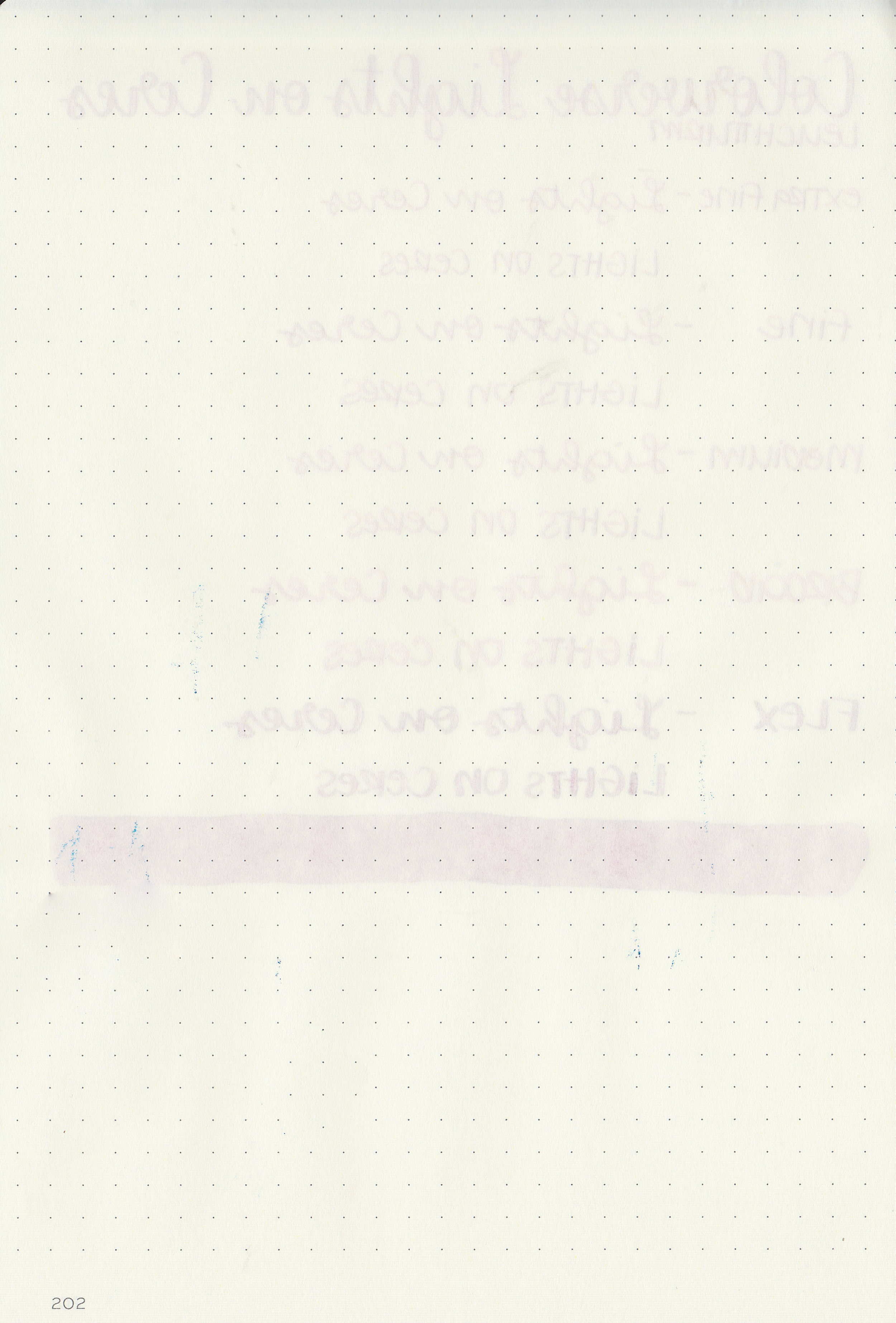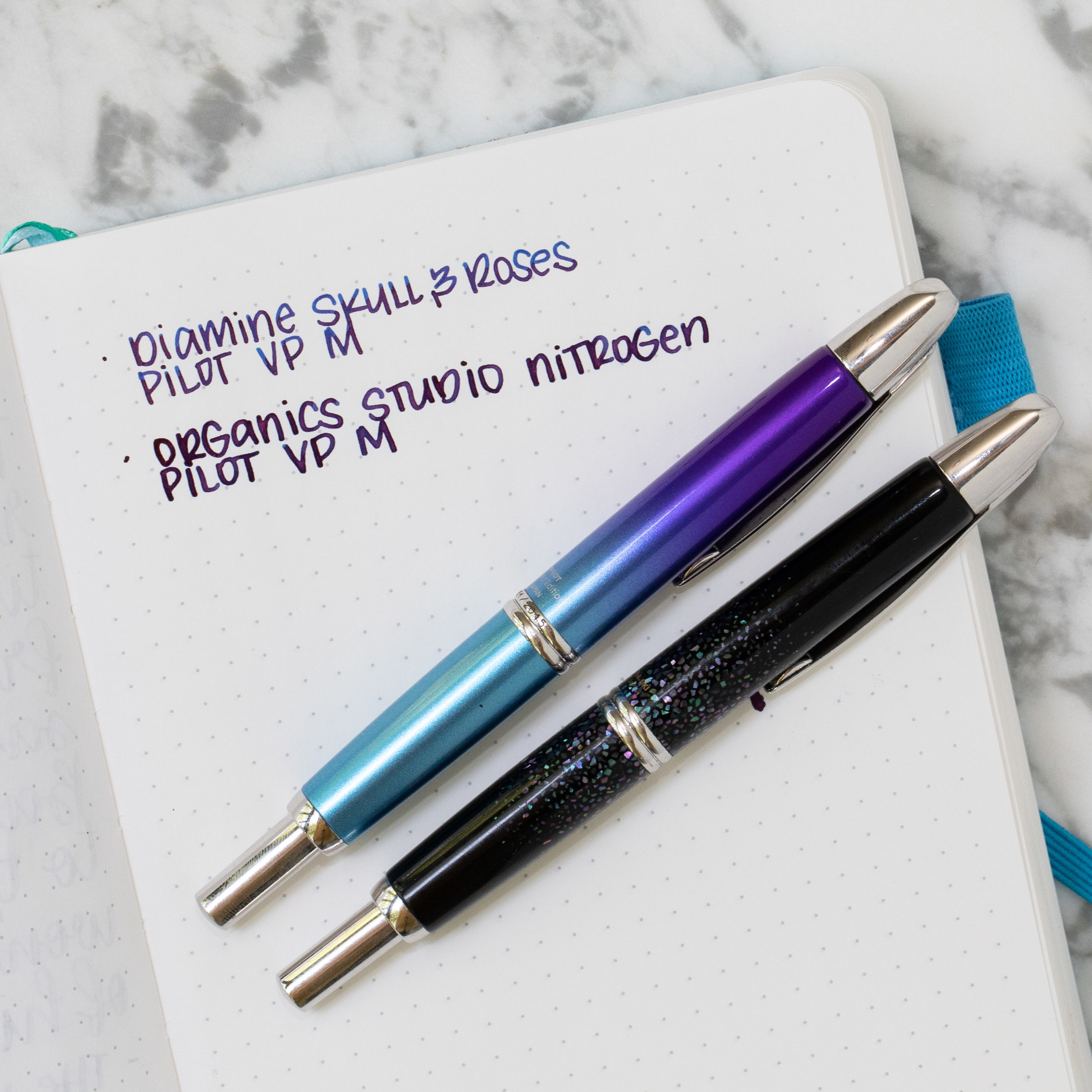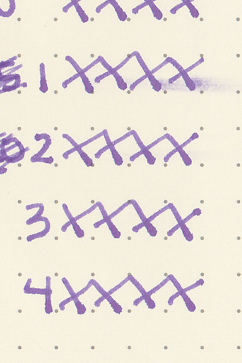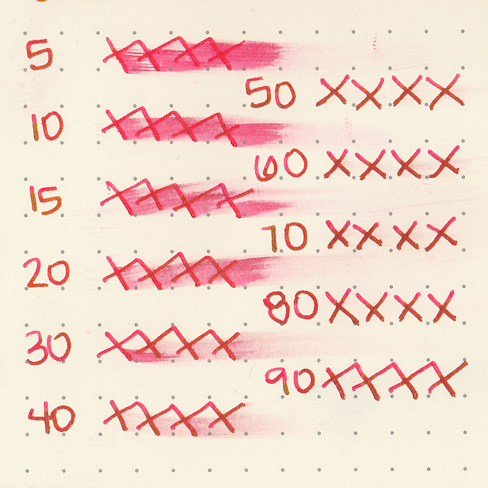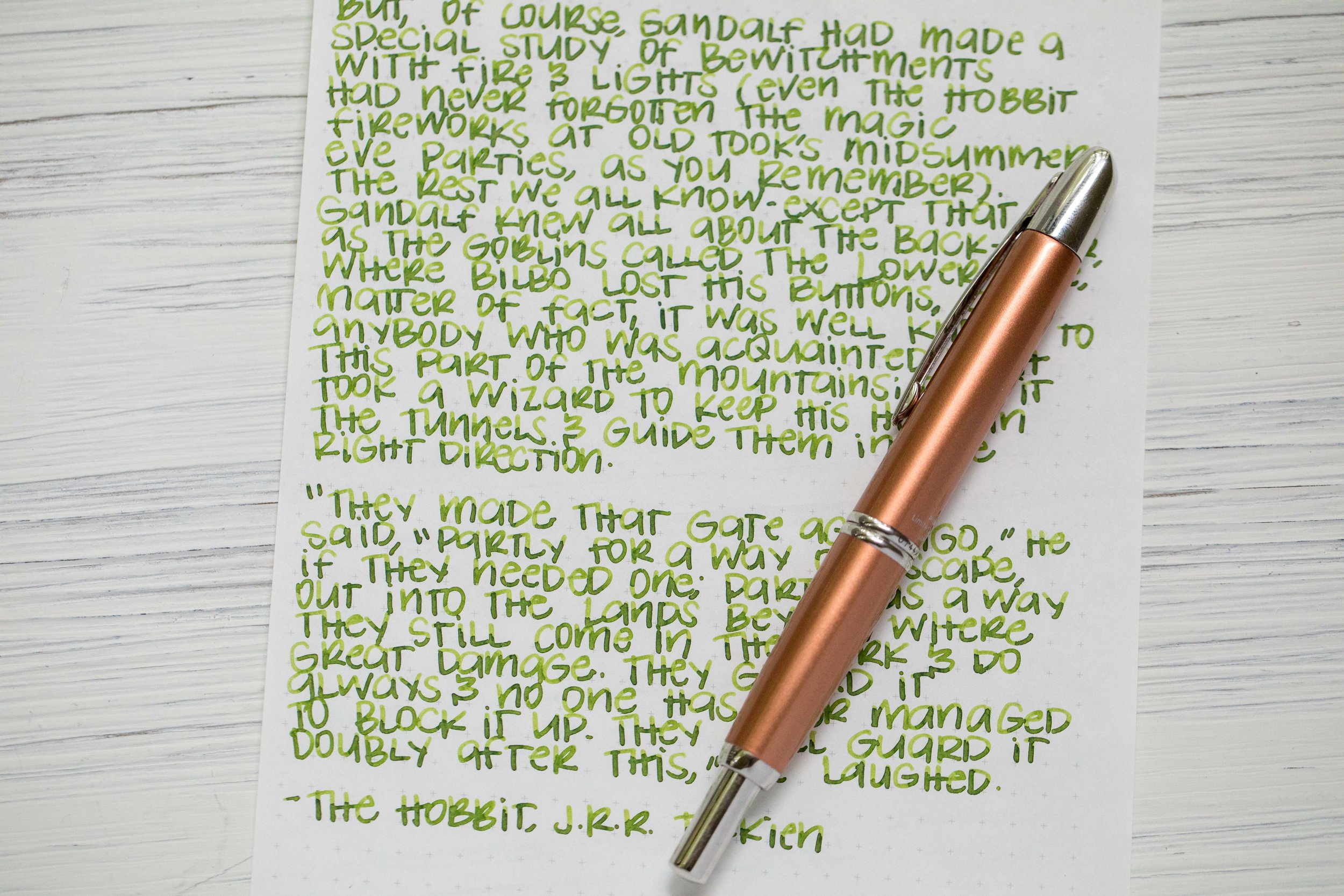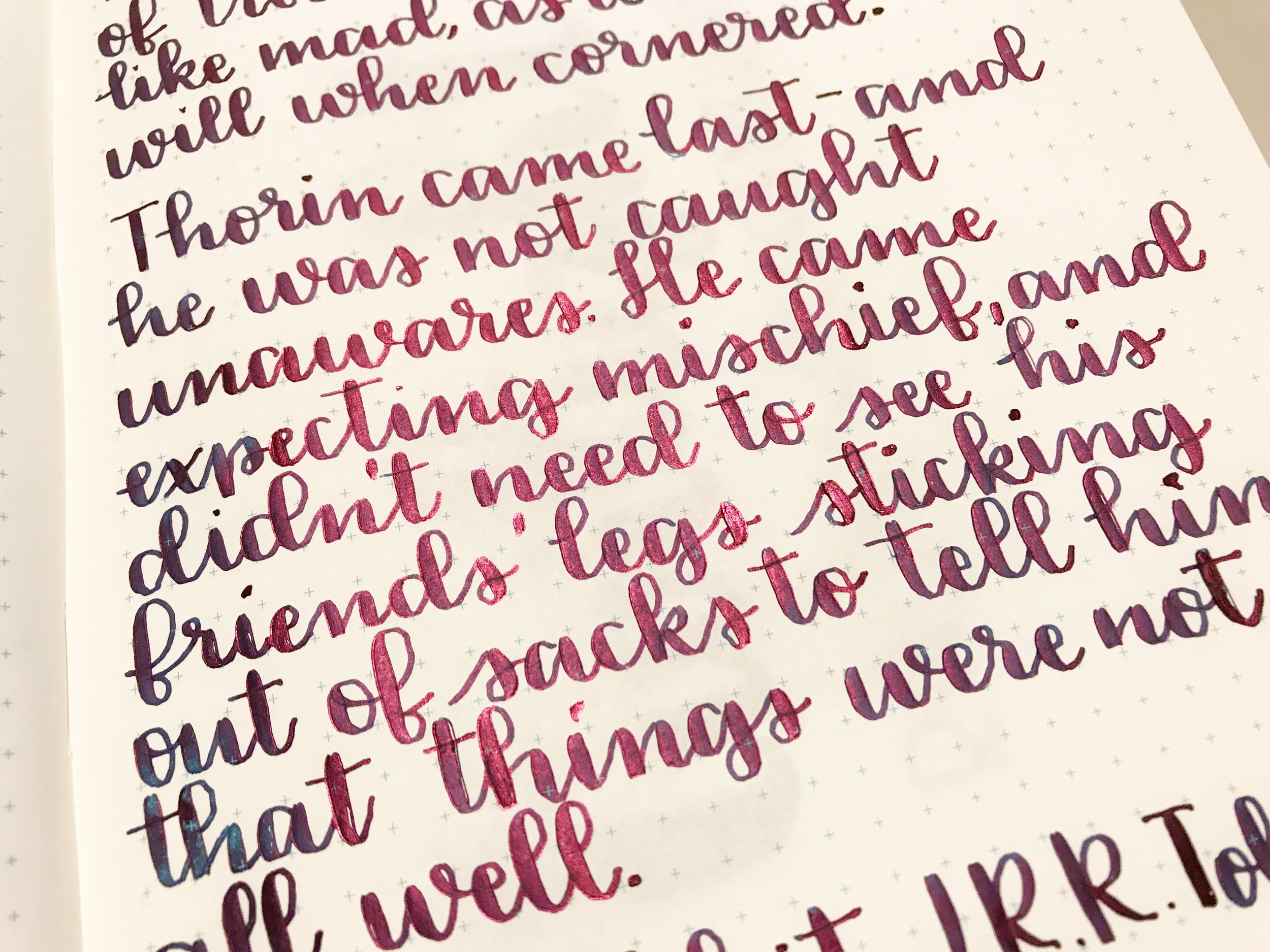Fountain Pen Ink Properties
/I had a reader contact me recently and ask for a guide to the basic fountain pen ink properties, an ink properties 101 if you will. I'm happy to take requests, so let's take a look at fountain pen ink properties.
Feathering:
Feathering is when the ink spreads out from the writing like tiny little feathers on a baby duck. A good ink will stay where it is put, and not move.
This writing was done with Diamine 1864 Blue Black and a Visconti Homo Sapiens Bronze Age, medium nib. The ink spread out from the writing. It is most noticeable on the words "could" "struggled" and "him". Paper can make a big difference when it comes to feathering. Diamine 1864 Blue Black feathers on this G. Lalo Mode de Paris stationery, but it doesn't feather at all on some other papers. Most fountain pen inks will feather on cheap copy papers.
Show Through:
Show through, aka "ghosting" is when you can see the shadow of the writing on the other side of the page. This writing was done with Colorverse Lights on Ceres on Leuchtturm paper. Generally most fountain pen inks have medium show through unless you use really good paper. I would say an ink has high show through if it's so obvious that I wouldn't feel comfortable using the other side of the page.
Bleeding:
Bleeding is when the ink seeps to the back side of the page. The image above is the back side of a page of Leuchtturm, written with Montegrappa Violet. There was at least a little bit of bleeding in every nib size, and a lot of bleeding in the broad nib.
Water resistance:
Water resistance is when an ink does not wash away when exposed to water. Most fountain pen inks are not water resistant at all. Some inks have medium water resistance, where some ink washes away, but you might still be able to read it, and some inks have high water resistance where the ink does not budge when mixed with water. Water resistant inks are great for sketching and mixed media.
On the left is Robert Oster Pinky, which washes away easily, and on the right is Rohrer and Klingner Vroni, which is highly water resistant. Brands known for water resistance: Noodlers, the SketchINK line from Rohrer and Klingner, De Atramentis Document ink, and a lot of the Platinum inks.
Pigment:
Pigmented inks are inks that have tiny particles of pigment added to the ink to make it look darker. In my experience, pigmented inks have a higher water resistance than your average ink. Because of the tiny particles of pigment, these inks tend to clog fountain pens when left inked for a long time. I generally clean out fountain pens inked with pigment inks after a month. Brands with pigmented inks: Platinum Pigment inks, Sailor Pigmented inks, Rohrer and Klingner SketchINKs, and Organics Studio Pigment inks.
Flow:
Flow is a funny thing. In one pen an ink may feel wet, and in another it may feel dry. I used Pilot Vanishing Point medium nibs to write both lines above, the only thing different was the ink. Diamine Skull and Roses felt average, but Organics Studio Nitrogen felt much wetter. Not only is it by feel, but is sometimes visible because the wetter ink's writing is slightly wider than the average ink's. Flow can be different for different people, just based off of how much pressure they use when they write. If you write very lightly, an ink may feel dry, but if you have a heavy hand when writing, the ink may feel wet. If you are having trouble with a pen feeling too dry, sometimes you can fix it by using a wet ink. Brands I find wet overall: Monteverde, Noodler's, Sailor and KWZ. Brands I find dry overall: Pelikan 4001.
Lubrication:
Lubricated inks are inks that have an additive to make the ink flow easier and smoother. Monteverde uses what they call "ITF Technology" to make their inks smooth and lubricated. Noodler's has some inks that are specifically lubricated. Pilot Iroshizuku inks are often referred to as lubricated, but they aren't, they just have a nice wet flow.
Dry Time:
On the left is Noodler's Polar Purple, which dries in 2 seconds, the fastest I've ever seen an ink dry. On the right is J. Herbin Rouge Hematite, which can take up to 90 seconds to dry, the longest dry time I've ever seen. When I averaged the dry time of all the inks I've reviewed so far, the average dry time is 31.5 seconds. Paper and nib size has a big impact on dry time-an extra fine nib on Leuchtturm paper is going to dry much faster than a flex nib on Tomoe River paper. Inks that dry very fast do so by sinking into the paper, which usually has feathering as a side effect. I consider anything that dries faster than 15 seconds to be fast-drying, which you can learn more about here. The one brand that has the fastest drying inks I've seen is Noodler's.
Iron Gall:
Iron Gall inks were made from tannic acids and iron salts. They were the common ink used in Europe from the 5th century to the 19th century. Here's a great source to learn more about iron gall inks. Iron gall inks are generally water resistant and turn darker over time. They are higher maintenance, since they can damage your pen if left sitting for too long. Modern iron gall inks are generally pretty safe, but I would still suggest being attentive to how long you leave the ink in the pen. Brands with iron gall inks: Platinum, KWZ, Rohrer and Klingner, De Atramentis, and Stipula. There are a few brands with just one or two iron gall inks, such as Diamine Registrar's ink, Krishna's Lavender Black, Akkerman #10, etc.
Shading:
I used a broad Pilot Vanishing Point Copper LE filled with Robert Oster Jade.
Shading is when you can see two separate shades of color in one written letter. In the image above, the tops of the letters are a lighter green than the bottom of the letters. I've talked a lot about shading-you can see my full page on shading which breaks down levels of shading and examples of each. I've learned that for me, I get more shading if I print than if I write in cursive. When you pick up your pen more (like when you print) you leave larger puddles of ink in each letter than if you write in cursive, and don't pick up you pen as much. For me, I get the most shading when I use a Pelikan medium nib, or a Pilot broad nib. I would never tell someone to use a flex nib for the best shading, because it lays down way too much ink to actually get the most shading. Extra fine nibs generally don't put enough ink down to get shading, and flex nibs put down too much. European mediums, Japanese broads tend to be the sweet spot for coaxing the most shading you can out of an ink. Brands with good shading: Robert Oster, Colorverse, Monteverde, Diamine, etc.
Sheen:
I used a Pilot 912 FA with Organics Studio Emerson. The ink is blue with dark pink sheen.
Sheen is a soft luster on a surface. Sheen in an ink is an appearance that the ink shines with a different color, that appears metallic or shiny. Generally, the wetter your pen, the more sheen you will get. In the image above, you can see that Organics Studio Emerson sheens so much, that you mainly see the pink sheen, and not much of the underlying blue. Sheen is very paper dependent-a lot of inks will show sheen on Tomoe River paper if you put enough ink on the page, but only high or monster sheening inks will show sheen on Rhodia or Leuchtturm. Monster sheening inks have been very popular in the last few years, but I've really struggled with them since they tend to stain pens and smear across the page, even after drying for a few days. You can read more about sheen here. Brands with monster sheeners: Organics Studio and Diamine. Brands with high sheeners: Sailor, Colorverse, Diamine, Monteverde, and Blackstone.
Shimmer:
Shimmer inks have little shimmer particles added to the ink. Shimmer inks are called different things by different brands: Robert Oster has Shake 'N' Shimmy, De Atramentis has Pearlescent Inks, Nemosine has Twinkle Inks, Colorverse has Glistening Inks, etc. The shimmer settles to the bottom of the pen or bottle, so when using shimmer inks you need to shake the bottle before filling a pen, and rotate the pen frequently when writing so the shimmer stays in suspension. I don't recommend leaving shimmer ink in a fountain pen for more than a month-pen hygiene is important, and shimmer inks are a bit higher maintenance than most inks. I usually use an ultrasonic cleaner (this is the ultrasonic cleaner I use) after using shimmer ink, just because the shimmer can be hard to completely clean out. You can learn more about shimmer inks here. Brands with shimmer inks: Ancient Song, J. Herbin, Diamine, Robert Oster, De Atramentis, Nemosine, Colorverse, Birmingham Pens, and Organics Studio (BP and OS just started doing some shimmer this year).
Other Properties:
Noodler's inks have some special properties that don't apply to other brands. Goulet Pens has a great chart that shows the different Noodler's inks and their properties.
Bulletproof: uv resistant, bleach resistant (forgery-resistant)
Eternal: archival, fade resistant
Forgery-resistant: impervious to alcohol, solvents
Fluorescent: glows under UV black light
Freeze-resistant: has a low freeze temperature
Favorite Properties:
My favorite ink property is shading, my second favorite is lubricated, and my third is sheen. I love wet, juicy inks that have lots of shading. What's your favorite? Let me know in the comments below!


